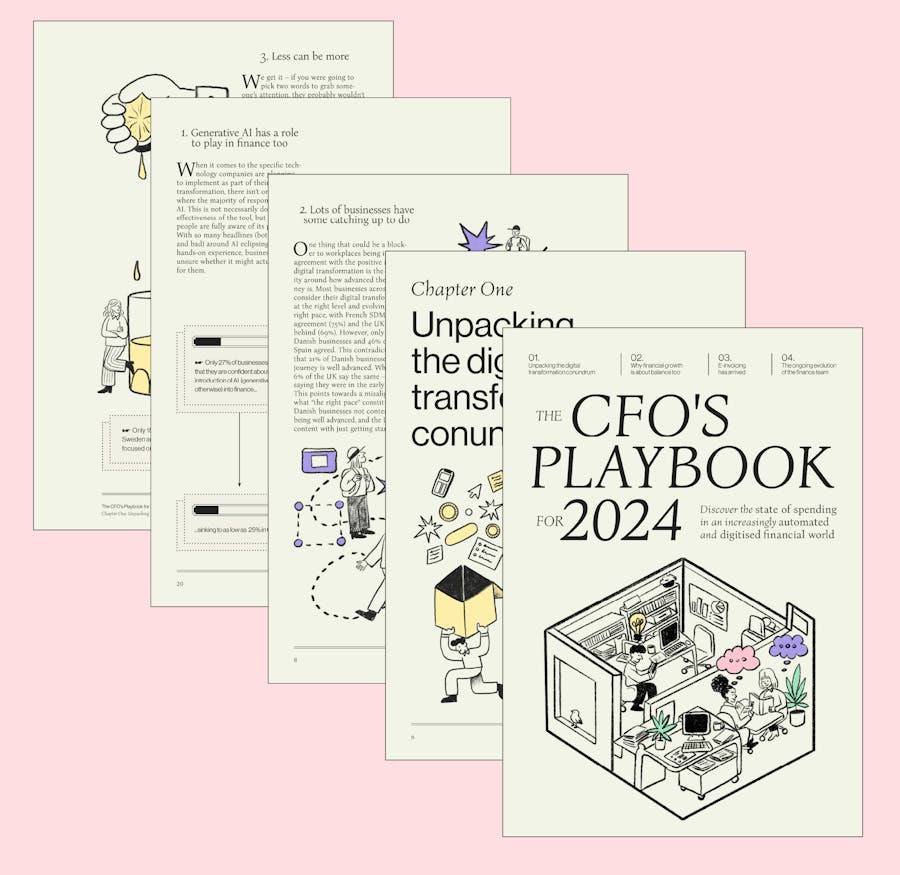
The CFO agenda: 6 insights for effectively managing financial digital transformation
Digital transformation is on the radar for most finance leaders this year.
In fact, in our CFO’s playbook for 2024 we discovered that 68% of senior decision-makers are rolling out some form of digital transformation in their organisations.
To dive deeper into this insight, in our recent playbook-inspired webinar, we heard from top finance leaders about how this digital transformation will pave the way for more efficient business processes.
Ross Latta, Co-Founder, CEO and CFO at Macrofin shared top tips in preparing for a new system. Oliver Wimshurst, FinOps Lead at Rora outlined how technology is changing the role of the finance team, while Faith Metobo, Senior Finance Manager at Blinkist, told us how to get from A to B when considering digital transformation.
Missed the live event? Don’t sweat it. Here are the key takeaways from the conversation 👇
1. Successful finance teams are agile and adaptable
What makes a finance team successful is different for every business. Shifts in regulatory frameworks, business models, market dynamics, and individual financial challenges and opportunities can vary quite a lot between industries.
And according to Ross, it’s ‘the ones with open mindsets for continual improvement and adaptation to new systems. And who incrementally make changes to help automate and make processes more stable and efficient using technology.’
Understanding and tailoring their strategies to the nuances between sectors is what makes an effective finance leader. Not to mention Faith’s point that ‘having a data-driven solution that’s agile and scalable, always with cybersecurity in mind’ will help businesses figure out what they need.
But not getting caught up in a stagnated industry is Ollie’s go-to.
‘The way traditional accounting is taught is paper based, handwritten and very far away from what real work is like. Finance needs to be looking at new technologies.’
But how can finance find the space and head room to think about working beyond the day job and managing the pressures? For Ollie, easing the strain comes from open communication and working together, while having strong leaders who inspire curiosity in people about ways of improving upon their processes is Ross’s two cents.
The finance team has a sense of community where a problem shared is a problem halved. So for Faith, it all comes down to sacrificing time in the present to solve issues that save time in the future.
2. How businesses can keep up the digital transformation momentum
Our playbook discovered that only 6% of businesses say their digital transformation journey is advanced. So it’s clear that lots of businesses still have some catching up to do.
‘CFOs may have less experience than IT leaders in overseeing digital transformation and could be guilty of putting it off in favour of what’s in their comfort zone.’
Peeling back the layers of Ross’s insight, success comes from having the proper team and enabling them with enough support. Leaders should shoulder the responsibility of empowering their teams with the right help and a dedicated champion to lead the charge.
What’s more, meticulously planning the roadmap and possible challenges helps to avoid potential roadblocks. ‘When going into the vendor selection, stay focused on your problems and don’t be distracted by the shiny bells and whistles of other softwares.’
James Keating, CMO at Pleo and moderator of the webinar, echoes Ross’s point, saying that ‘building a solid foundation and having a plan and strategy’ is the most important part. But with rising pressure and a fear of failure, do finance teams even have the space to drive this innovation?
‘Investor and general reporting, year-end, audits, funding rounds - it can be hard to get the space to plan. But by working with experts and guides, it can be broken down into sizable chunks.’ -Ross Latta, Co-Founder, CEO and CFO at Macrofin
And potentially the most common barrier: time and cost. Ollie often sees decision-makers worrying about how much an upgrade for finance will come to, but they forget to see it as a future-proofing of the business. ‘Don’t see it as an overhead, but an investment.’
And of course, ‘be intentional about what you’re trying to do.’
3. The evolution of the finance team, beyond 2024
Finance is no longer just about balancing budgets. We’ve seen a clear shift of finance leaders moving from traditional compliance and bookkeeping to proactive advisors and strategic leaders.
Having meaningful conversations around topics from spend-to-pipeline ratios to payback periods, revenue generation strategies and tech investments means decision-making across departments is more collaborative and valuable.
Keeping up the momentum into 2024 and beyond is the goal. But getting started might not come naturally for some businesses.
In Ross’s words, ‘the goal is to get the finance team adding more value to the business.’ He says that accountants' mindsets are changing to be more focused on technology but that hitting those more strategic goals is reliant upon supportive and effective leadership. And collaboration, continuous improvement and bringing the finance team to different departments by enabling people to ask the right questions is just as important for Faith.
‘Businesses need to ensure the systems and processes are functional and producing accurate data. Otherwise the business will end up debating and wasting time on whether the numbers and data are accurate, instead of drawing insights from it to help the business.’
But most of all, it’s technology that’s changing the role of the finance team. Ollie used to receive shoeboxes of receipts, which he had to go through and type into Excel one by one.
‘And now we’ve got amazing technologies like Pleo where we can capture receipts electronically and that information gets imported into the accounting system.’
‘We’re at this amazing intersection where simpler tasks are being automated so the finance team has a great opportunity to be more business partners.’
The finance team is a privileged intersection between data sources across the business. Ollie often brings metrics to the marketing team to ask questions about certain numbers or strategies that can be worked on since the business wins through generating cash.
And the finance team is instrumental in helping with that.
4. Where to start with digital transformation
‘It’s never too early or late to start talking about digital transformation.’ -Oliver Wimshurst, FinOps Lead at Rora
Having a starting point in place is good housekeeping. But having a start and an end point sets the business up for success.
For Faith, it all starts with assessing where you are now: have an A point and a clear map of how to get to B by speaking to accountants, talking about pain points and understanding exactly where you want to be.
‘Pick the easy battles first. Think about how to transform or how to bring things onto one platform.’
Some companies might jump the gun and skip straight to vendor selection so they can rush implementation. But preparing for the new system takes time.
For Ross, plotting out a basic checklist of key areas to keep in mind helps his team stay on track:
- Preparation and readiness: Bring experts in to map out all the processes and pinpoint the pain for a clearer view of the potential benefits.
- Set out the roadmap: Whether the company is bracing for IPO, implementing a new billing process or getting ready for growth, knowing why the new processes are needed is essential. Take that homework into vendor selection and don’t be afraid to push back if the resource isn’t right.
- Equip the team: Making sure the team has all the resources they need in place, with adequate time and capacity to implement it, will avoid problems down the line.
- Provide ongoing support: Getting more out of each piece of software is important for upfront planning and not getting caught out later on. Continually adding to the future roadmap and supporting the implementation means adding more solutions as needed and plugging them into the current tech stack.
5. Striking the right balance between growth and stability to remain resilient
‘71% of businesses state that growing revenue is their key objective in 2024.’
We’ve seen from the CFO’s playbook that the key to resilient growth is around the balancing act, where growth is a target but stability is the core. But how can leaders support their teams and clients in striking the right balance?
‘Be realistic and data-driven with forecasting and transparent with your team,’ says Faith, ‘as being realistic removes the ambiguity and uncertainty.’
‘Different teams need to communicate and be partners to the entire organisation. Having the data available helps to ground expectations in reality.’
‘People need to know what’s happening in different teams, budgets and the organisation as a whole so they can shift quickly.’ She continues, ‘and finance can be a big team player in combining all these functions within analysis and accounting. Procuring this information for other teams can drive good decision making.’
And during times of uncertainty, getting everything right isn’t always a piece of cake.
Speaking from personal experience, Ross’s approach has been to minimise inflexible cost commitments wherever possible. He says ‘it might mean paying higher monthly fees in the short term but it allows you to pivot quicker. If there’s cost pressures you need to focus on stability, but then you’ve got the flexibility to reduce your cost base.’
He adds, ‘evaluate your business case for any new fixed spend really closely. And rigorously challenge the potential benefits that might come from it before committing to a fixed cost of putting in a new system or hiring more headcount for the business.’
And having flexibility can have other bonuses for businesses too. For Ollie, ‘the ability to be agile is a big competitive advantage of smaller startups.’
‘Faster decision making makes everything easier and good data and transparency accelerates it and offers competitive advantage.’
6. Differentiating between spend and expense
The playbook found that half of businesses consider expense and spend as two different things. But only 27% have clear guidelines on how they differ.
In Ollie’s opinion, ‘it’s very much a communication issue.’ He thinks that ‘historically, people have seen finance as this guy in a suit who’s siloed in a corner and people don’t find him approachable. I find that really upsetting because one of my favourite things about the job is meeting new people and getting to talk, so I want the rest of the business to come and talk to me if they don’t know the difference between spend and expense.’
‘Finance should not be this mysterious thing: In terms of the actual business performance, the business is always going to perform better when everyone understands the commercials and how the money is being generated.’
The best finance teams are the ones who are willing to stand in front of the entire business and have that conversation, so asking the finance team questions is Ollie’s main plea.
But communication is a two-way street: Faith clearly communicates cost centres with her team to help them manage their spend. ‘Small things can balloon if you don’t keep an eye on them. We have different spend categories for smaller things but monitor bigger things like budgets much more in detail.’
And of course, centralising spend onto one system with consistent reporting, segmentation, correct tags and well-thought-out accounting codes is Ross’s secret recipe to telling the two apart.
‘Categorising by one-off spend and recurring spend is essential to identifying where cost and savings can be consolidated.’
Phew! There you have it. Knowing where to start with digital transformation is a challenge facing most finance leaders in 2024. Whether it’s planning your route from A to B, getting a headstart and keeping up the momentum or embracing the changing role of the finance team, digital transformation brings positive change to every part of the business.
And why not get started with an all in one spending solution that can help with all of the above? Talk to us today and see how Pleo can fit into your business goals for 2024.

The CFO's playbook for 2024
Discover the state of spending in an increasingly automated and digitised financial world
Powered in the UK by B4B partnership
You might enjoy...

Optimise your IT spend: How Pleo can save you time and money
With these handy Pleo features at your fingertips, you can stress less about your spending and get back to making sure your business is oper...

Mastering spend management: Get full control over your company spend with Pleo
Your one-stop-shop for everything you need to know about how Pleo can help you manage your business’s spend.

How the rise in mobile payments will affect businesses in 2024
Learn how businesses can leverage mobile payments to better cater to customers.
.jpg?ixlib=gatsbyFP&auto=compress%2Cformat&fit=max&rect=0%2C256%2C1536%2C1536&w=60&h=60)